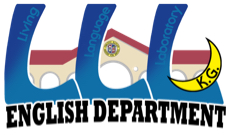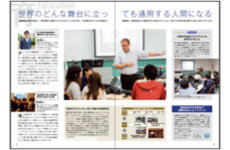English Education

-
Goals
(1) 総合的コミュニケーション能力の育成
科学技術の分野において,英語で正確かつ論理的に自分の考えを相手に伝える能力,また,相手の考えを正確に理解できる能力を身につけさせる。
(2) 自らコミュニケーション能力を発展させる意欲の育成
英語の授業で身につけた英語力を基礎に,自ら英語によるコミュニケーション能力を発展させる意欲を育てる。
(3) 異文化交流・異文化理解を図る態度の育成
将来、国際的な環境の中で活躍できるように,自ら積極的に異文化交流・異文化理解を図る態度を身につけさせる。
-
Classes
The School of Science and Technology offers a progressive, integrated English as a Foreign Language curriculum designed to prepare students to successfully use English throughout their academic and professional careers, as well as as in their daily lives. The series of English coursework consists of four semesters of Reading, Writing and Communication course required for all freshmen and sophomore students. An elective course, SciTech English, is available for juniors interested in further honing their English skills for scientific and technological purposes.
Freshmen Course Description
Reading 1A
Objectives
This course aims to improve students' reading ability. In this semester, the theme is ‘description’ and ‘reason.’ The course features both intensive reading (reading slowly and carefully) and extensive reading (reading a lot without worrying about the details). By doing extensive reading, students are trained to read without depending on Japanese translation.
Outcomes
By the end of the semester, students should be able to understand how sentences are connected and organized, how to find main ideas, how to identify key words/sentences, and how to scan for necessary information. During this course, students should be able to improve basic reading comprehension skills required to read descriptive and reasoning type passages written for scientific readers. A vocabulary quiz is given each month (three times in total). Students should gain up to 750 basic English vocabulary words through the quizzes.
Reading 1B
Objectives
The main aim of Reading IB is to improve basic reading skills that students gained in Reading IA. The course consists of two types of reading lessons: intensive and extensive reading exercises. In addition to ‘description’ and ‘reason,’ ‘problem-solution’ will be introduced as a main theme of this course. Extensive reading is another focus in IB; students will read a number of graded readers outside the class, write book reports, and try to read without depending on Japanese translation.
Outcomes
By the end of the semester, students should be able to understand how a whole essay is organized and how the main idea is built up with supporting sentences in descriptive, reasoning and problem-solving passages. During this course, students should be able to improve basic reading comprehension skills required to read descriptive, reasoning and problem-solving passages written for scientific readers. Students also continue to gain vocabulary up to 1500 words including 750 words they gained in the first semester.
Writing 1A
By the end of the course, students should be able use a computer to compose MS Word documents and blog entries. Students should also be able to write paragraphs with a clear topic sentence, good supporting sentences and a closing sentence, and use basic grammar to express themselves. In addition, students should also be able to analyze and write a basic five paragraph essay explaining their reasons on a given topic by the end of this course.
Writing 1B
The main purpose of this course is to expand student knowledge of essay writing to include the following rhetorical patterns: problem/solution and comparison/contrast. Students will learn how these forms are constructed, how to identify their key parts, and the process for producing their own written work. Students will also learn different ways to write the elements of effective essay introductions and conclusions. Students will further develop their proficiency at writing blogs and will also be introduced to the basics of professional e-mail writing in English.
Communication 1A & 1B
Objectives
To equip students with English language skills with a primary emphasis on speaking and listening skills. To provide students with guidance and practice in basic conversation and discussion skills. To provide students with guidance and practice in academic listening, speaking, and presentation skills. To engage students in academic speaking and listening activities across general topics. To help students improve their relative English comprehensibility through pronunciation practice. To provide students with instruction and practice toward improving their TOEIC listening test scores.
Outcomes
By the end of the semester, students should be able to effectively communicate in spoken English across different levels of formality from casual conversation, discussions, to academic presentations. Speeches and presentations may include introduction speeches, Show & Tell, world’s best invention, advertising a new invention, favorite scientist, etc. Students should also be able to comprehend spoken English and demonstrate their comprehension through spoken responses, writing, and comprehension checks such as TOEIC listening quizzes and tests. Students are also expected to use spoken English to express their ideas across a variety of topics through conversation activities. They should also be able to demonstrate a comprehensible level of English pronunciation.
Sophomore Course Description
Reading 2A
By the end of the course, students should be able to utilize the following reading comprehension skills: skimming for stated main ideas, scanning for key words and concepts, identifying word parts, identifying stated and implied main ideas, and understanding inferences. During the course, students will also be introduced to timed reading techniques to help them learn how to read faster, test-taking strategies that can be employed on TOEFL, TOEIC, and similar exams, and extensive reading activities, games, and puzzles designed to encourage reading for pleasure and making daily reading a habit.。
Reading 2B
By the end of the course, students should be able to utilize a combination of reading comprehension skills to quickly make sense of challenging TOEFL and TOEIC passages and other reading material. During the course, students will also work with timed reading techniques to help them read faster, test-taking strategies that can be employed on TOEFL, TOEIC, and similar exams, and extensive reading activities, games, and puzzles designed to encourage reading for pleasure and making daily reading a habit.
Writing 2A
By the end of the course, students should be able to write academic essays of various rhetorical styles incorporating reported speech and statistics correctly. Students should be able to not only express their ideas and opinions in writing but also find appropriate sources to support their opinions. Finally, students will have further developed their proficiency at expressing themselves on blogs and worked on teacher-determined problematic grammatical structures by the end of this course.
Writing 2B
By the end of the course, students should be able to write a substantial research essay on a topic related to their academic major. This essay will incorporate reported speech, statistics, and other information from several different sources. Students should be able to not only express their ideas and opinions in writing but also find appropriate sources to support their opinions. Finally, students will have further developed their proficiency at expressing themselves on blogs and worked on teacher-determined problematic grammatical structures by the end of this course.
Communication 2A & 2B
Objectives
To equip students with English language skills with a primary emphasis on speaking and listening skills. To provide students with guidance and practice in basic conversation and discussion skills. To provide students with guidance and practice in academic listening, speaking, and presentation skills. To engage students in academic speaking and listening activities across general and science/technology-related topics. To help students improve their relative English comprehensibility through pronunciation practice. To provide students with instruction and practice toward improving their TOEIC listening test scores.
Outcomes
By the end of the semester, students should be able to effectively communicate in spoken English with a high level of ability across different levels of formality from casual conversation, discussions, to academic presentations. Speeches and presentations may include scientific data reporting, global contributions to science and technology, a demonstration speech, creating and reporting the results of a scientific survey, etc. Students should also be able to comprehend spoken English and demonstrate their comprehension through spoken responses, writing, and comprehension checks such as TOEIC listening quizzes and tests. Students are also expected to use spoken English to express their ideas across a variety of topics through conversation activities including science and technology-related topics using critical thinking skills. They should also be able to demonstrate a comprehensible level of English pronunciation.

